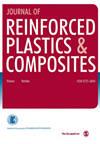Exploring the potential of CuO nanoneedles and CNT/PVC nanocomposites in medium voltage cable technology
IF 2.2
3区 材料科学
Q3 MATERIALS SCIENCE, COMPOSITES
引用次数: 0
Abstract
This study focuses on the development of CuO nanoneedle and multi wall carbon nanotube (CNT) reinforced poly (vinyl chloride) (PVC) nanocomposites for medium voltage cable applications. CuO nanoneedles were synthesized using a pulsed wire evaporation technique and integrated with CNTs to create CuO/CNT nanocomposites. The nanocomposites were then used to reinforce PVC films through a solution casting method. Microstructural characterization confirmed the uniform dispersion of CuO nanoneedles and CNTs concentrations (0–0.4 wt%) within the PVC matrix. Microstructural characterization by XRD, SEM, and TEM confirmed the formation of CuO nanoneedles (diameter ∼4 nm, length 200–250 nm) and their uniform dispersion within the PVC matrix along with CNTs. Optical studies revealed reduced optical bandgap and Urbach tail width in PVC/CuO/CNT nanocomposites compared to neat PVC/CuO. Electrical characterization showed significantly improved AC conductivity (up to eight orders of magnitude) with increasing CNT loading, attributed to the formation of efficient charge transport networks. Dielectric studies revealed concurrent improvements in dielectric permittivity and losses with CNT addition. Simulations demonstrated a more uniform electric field distribution in PVC/CuO/CNT nanocomposites, mitigating hotspots. The synergetic effects of CuO nanoneedles and CNTs led to excellent improvements in the electric properties of PVC, underscoring their potential in medium voltage cable applications.探索 CuO 纳米针和 CNT/PVC 纳米复合材料在中压电缆技术中的应用潜力
本研究的重点是开发用于中压电缆的氧化铜纳米针和多壁碳纳米管(CNT)增强聚氯乙烯(PVC)纳米复合材料。利用脉冲线蒸发技术合成了氧化铜纳米针,并与碳纳米管结合生成了氧化铜/碳纳米管纳米复合材料。然后通过溶液浇铸法将纳米复合材料用于增强聚氯乙烯薄膜。微观结构表征证实了 CuO 纳米针和 CNTs(0-0.4 wt%)在 PVC 基体中的均匀分散。通过 XRD、SEM 和 TEM 进行的微观结构表征证实了 CuO 纳米针(直径 ∼ 4 nm,长度 200-250 nm)的形成及其与 CNTs 在 PVC 基体中的均匀分散。光学研究表明,与纯 PVC/CuO 相比,PVC/CuO/CNT 纳米复合材料的光带隙和 Urbach 尾宽都有所减小。电学表征显示,随着 CNT 负载的增加,交流电导率明显提高(高达 8 个数量级),这归因于形成了高效的电荷传输网络。介电研究表明,添加碳纳米管后,介电常数和损耗同时得到改善。模拟结果表明,PVC/CuO/CNT 纳米复合材料中的电场分布更加均匀,从而减少了热点。铜氧化物纳米针和碳纳米管的协同效应使聚氯乙烯的电性能得到了极大改善,从而凸显了它们在中压电缆应用中的潜力。
本文章由计算机程序翻译,如有差异,请以英文原文为准。
求助全文
约1分钟内获得全文
求助全文
来源期刊

Journal of Reinforced Plastics and Composites
工程技术-材料科学:复合
CiteScore
5.40
自引率
6.50%
发文量
82
审稿时长
1.3 months
期刊介绍:
The Journal of Reinforced Plastics and Composites is a fully peer-reviewed international journal that publishes original research and review articles on a broad range of today''s reinforced plastics and composites including areas in:
Constituent materials: matrix materials, reinforcements and coatings.
Properties and performance: The results of testing, predictive models, and in-service evaluation of a wide range of materials are published, providing the reader with extensive properties data for reference.
Analysis and design: Frequency reports on these subjects inform the reader of analytical techniques, design processes and the many design options available in materials composition.
Processing and fabrication: There is increased interest among materials engineers in cost-effective processing.
Applications: Reports on new materials R&D are often related to the service requirements of specific application areas, such as automotive, marine, construction and aviation.
Reports on special topics are regularly included such as recycling, environmental effects, novel materials, computer-aided design, predictive modelling, and "smart" composite materials.
"The articles in the Journal of Reinforced Plastics and Products are must reading for engineers in industry and for researchers working on leading edge problems" Professor Emeritus Stephen W Tsai National Sun Yat-sen University, Taiwan
This journal is a member of the Committee on Publication Ethics (COPE).
 求助内容:
求助内容: 应助结果提醒方式:
应助结果提醒方式:


